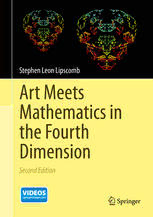
Art Meets Mathematics in the Fourth Dimension PDF
Preview Art Meets Mathematics in the Fourth Dimension
Stephen Leon Lipscomb Art Meets Mathematics in the Fourth Dimension Second Edition Art Meets Mathematics in the Fourth Dimension Stephen Leon Lipscomb Art Meets Mathematics in the Fourth Dimension Second Edition 123 StephenLeonLipscomb EmeritusProfessorofMathematics UniversityofMaryWashington Fredericksburg,VA,USA GeraldEdgarsuggestedtheArtMeetsMathematicsintheFourthDimensiontitle. Videostothisbookcanbeaccessedat http://www.springerimages.com/videos/978-3-319-06253-2 ISBN978-3-319-06253-2 ISBN978-3-319-06254-9(eBook) DOI10.1007/978-3-319-06254-9 SpringerChamHeidelbergNewYorkDordrechtLondon LibraryofCongressControlNumber:2014940943 MathematicsSubjectClassification:28A80,55M10,97M80 SpringerInternationalPublishingSwitzerland2011, 2014 Thisworkissubjecttocopyright. AllrightsarereservedbythePublisher, whetherthewholeorpartofthema- terialisconcerned, specificallytherightsoftranslation, reprinting, reuseofillustrations, recitation, broadcasting, reproductiononmicrofilmsorinanyotherphysicalway,andtransmissionorinformationstorageandretrieval,elec- tronicadaptation,computersoftware,orbysimilarordissimilarmethodologynowknownorhereafterdeveloped. Exemptedfromthislegalreservationarebriefexcerptsinconnectionwithreviewsorscholarlyanalysisormaterial suppliedspecificallyforthepurposeofbeingenteredandexecutedonacomputersystem,forexclusiveusebythe purchaserofthework. Duplication ofthispublication orparts thereofispermittedonlyundertheprovisionsof theCopyrightLawofthePublisher’s location, initscurrentversion, andpermissionforusemustalways beob- tainedfromSpringer. PermissionsforusemaybeobtainedthroughRightsLinkattheCopyrightClearanceCenter. ViolationsareliabletoprosecutionundertherespectiveCopyrightLaw. Theuseofgeneraldescriptivenames,registerednames,trademarks,servicemarks,etc.inthispublicationdoesnot imply,evenintheabsenceofaspecificstatement,thatsuchnamesareexemptfromtherelevantprotectivelawsand regulationsandthereforefreeforgeneraluse. Whiletheadviceandinformationinthisbookarebelievedtobetrueandaccurateatthedateofpublication,neither theauthorsnortheeditorsnorthepublishercanacceptanylegalresponsibilityforanyerrorsoromissionsthatmay bemade.Thepublishermakesnowarranty,expressorimplied,withrespecttothematerialcontainedherein. Printedonacid-freepaper SpringerispartofSpringerScience+BusinessMedia(www.springer.com) Dedicated to James Cornelius Perry August 9, 1935 – January 10, 2011 Circa2000, Perrycreatedan isotopy thatmoves the4-web fromthe4th dimension into humanview whilepreservingits fractal dimension andexposing its self-similarity. and Eugene LeRoy Miller November 5, 1939 – September 4, 2012 August2000, Miller creates firstphysical-art representationof the4-web. Basic4-webStructurefromthe Fourth-Dimension (Graphic by Chris Dupilka) “The most beautiful thing we can experience is the mysterious. It is the source of all true art and science.” Albert Einstein AsaninstanceofEinstein’sstatement,considerthemysteriousquestion. Howcanweusearttopicturetheintersectionofalineanda3-sphere? Knowingthatthe3-sphereisa3-manifold,onemayincorrectlyguess Foralocalview,pictureaneedleinanicecube. But(section)40showsthatalineintersectsa3-sphereinatmosttwopoints. So the correctansweris Threeworksofart(pictures)arerequired: onecontainingnothing,another containingonedotofink,andanotherthatcontainstwodotsofink. The point is, pictures can convey “mysterious mathematical facts” to even non-mathematicians,andthistruismisthekeystoneofthisbook. Preface (Second Edition) Thetitleof the2011 firstedition is “Incipit” (herebegins), andits subtitleis thetitleofthis2014secondedition. Otheradjustmentsincludethefootnote onpage68where“skull”replaces“scull”;thetopofpage79where“−t(2m· b)”replaces“+t(2m·b)”;thethirdparagraphonpage80;themiddleofpage 82wherethePov-raycode-definitionof"sphere"iscorrected;andfinally,the top-rightof page 118 where“(12/d)2” replaces “(12/d)”. The first edition contains a Blu-ray HD Disc, and MPG-4 versions of the videos therein are available at Springer web sites: The author’s narration explainsthecoloringoftheGod’sImage? art,withbackgroundmusictheart is rotated, and a 4-web grid from the 4th dimension is moved into human view. Frames ofthesevideos areillustratedwithin thecolor-platesection. Forthecreationofthissecondedition,theauthorgivesthankstoSpringer editors AnnKostantandMarcStraussfortheirguidance and support. Spotsylvania,VA Stephen L. Lipscomb April 2014 About the Author AgraduateofFairmontStateUniversityBA;WestVirginiaUniversityMA,andtheUni- versity of Virginia Ph.D., where the late G. T. Whyburn (past president of the AMS) was his advisor. And prior to Chairing the Department of Mathematics, Physics, and Com- puter Science at the University of Mary Washington, Lipscomb was a U. S. Navy senior mathematicianinvolved withtheTridentMissilesystemandserved as Team Chairof an OperationalEvaluationoftheTomahawkMissilesystem. In the 1970s the author solved a half-century old embedding problem in dimension theory. Hissolution,uponreviewbyaTransactionsoftheAmericanMathematicalSociety (AMS) referee, was called “an outstanding contribution to dimension theory”. In 2009 theauthor’sfeaturearticleTheQuestforUniversalSpacesinDimensionTheoryappeared in the December issue of the Notices of the AMS, and his book Fractals and Universal Spaces in Dimension Theory was published in the outstanding Springer Monographs in MathematicsSeries. ItturnedoutthattheclassicalfractalsknownasSierpin´ski’striangle and cheese were corollary to the author’s solution. And at the beginning of the 21st Century,JamesPerryintroducedanotherexample(the4-web)oftheauthor’sconstruction thatlivedintheFourthDimension. Perry’sexampleisfundamentaltothisbook. During the 1990s, the author introduced an extension of Cauchy’s cycle notation in grouptheorytopathnotationinsemi-grouptheory. Heusedhispathnotationtoconstruct new semi-groups, e.g., the alternating semi-groups. By 1996, the author’s work with his path notation was documented by theAMSin Volume 46 Symmetric Inverse Semigroups ofitsprestigiousMathematicalSurveysandMonographsSeries. Circa 2000 the author realized, because the triangle is theHoly Grail of strength de- sign, that the 4-web would be ideal for practical applications. By 2005 he obtained a US patentanddesignedmedical4-webspinecages. ThenJesseeHuntcreated4-Web,Inc.,the cageseventuallybecameFDAapproved forhumanimplantation,andtheimplantsbegan in2011. In2014theUSPatentOfficeapprovedhis5-WebPatent. vii Preface Over time the impossible becomes understandable and partially possible. Here begins new art created by capturing pictures of objects that live in the 4th dimension. The new method is applied to the hyper-sphere, which is a higher-dimensional offspring of an ordinary sphere. We see an ordinary sphere, also called a 2-sphere, each time we look at a full moon or the sur- faceofabasketball,butthehyper-spherelives in the4th-dimensionbeyond humanview. A hyper-sphereis also called a3-sphere. The “global structure” of a hyper-sphere requires four dimensions, but humanvisionisonly3-dimensional. Inotherwords,itishumanlyimpossible to “see”ahyper-spherein the4th dimension. Nevertheless, the historical value of the hyper-sphere cannot be over- stated: Einstein used it in 1917 to describe the shape of our universe, and Dante, circa 1300 AD, used it to describe the Christian afterlife. These de- scriptionsarepresentedinchapters2,3,and4usingnumerousillustrations. Over time, our understanding of the meaning of dimension evolved. By 1970 a 4-web (think of a spider’s web) from the 4th dimension emerged. In the4-webcase,however,by2003itwasdiscoveredthatits“globalstructure” could be moved into human view (see left-side graphic above and reference [27]). The 4-web is an example of a construction that was applied in the article “On Imbedding Finite-Dimensional Metric Spaces”, which I published in theTransactions of the American Mathematical Society Vol. 211, 1975. While the ‘human view” of the 4-web is a relatively recent discovery, the idea of“reasoningwellwith images of objects”datesback tothelate1800s. For example, within the introduction of Poincaré’s famous Analysis Situs (1895), wefind ... geometry is the art of reasoning well with badly made figures. Yes, without doubt, but with one condition. The proportions of the figures might be grossly altered but their elements must not be interchanged andmustconservetheirrelativesituation. By moving the 4-web into human view, we “see” its structure: The line segmentsthatcomprisethe4-webareorganizedintofivegroups,eachgroup “just touching” the other four. As Poincaré might say, the five groups were notinterchangedandtheirrelativesituation was conserved. ix
